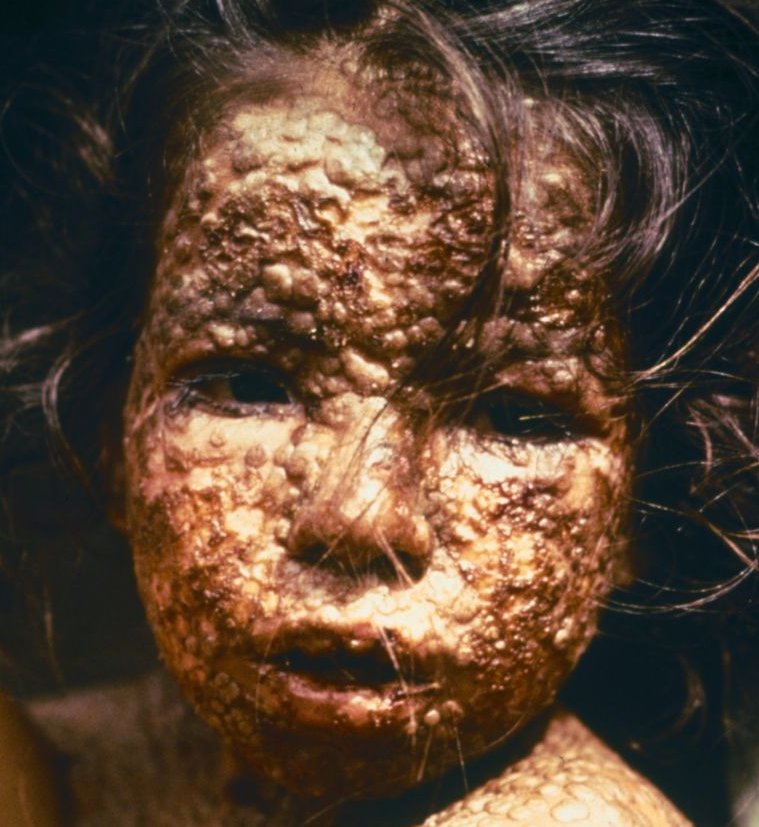
Pox.
Smallpox is the first and only human disease we have ever successfully eradicated—thanks to the very first vaccine ever developed. It’s quite the medical triumph. The very word “vaccine,” which we use to describe all other forms of protective inoculations, is an homage to the smallpox vaccine.
Yet, we don’t know what the vaccine is, exactly. For decades, researchers have mulled its sordid and muddled origins. Now, a recent report in the New England Journal of Medicine finally offers a genetic glimpse of its true identity—and it’s not what you might expect.
Most people know the general tale of the vaccine’s origin, which started with key observations: smallpox survivors obtained immunity; infection through a scratch spurred a milder sickness; and milkmaids, who sometimes developed pustules on their hands, seemed conspicuously above the fray. These observations fortuitously fused in the mind of Edward Jenner, who, in 1798, reported protecting a brave eight-year-old named James Phipps from smallpox with an inoculation from the lesioned hand of a cowpox-infected milkmaid, Sarah Nelmes. The inoculation was dubbed a vaccine, a term that stems from the Latin word vacca, for cow.
The first vaccine was wildly popular. It spread across the globe like, well, a virus. But, with scientists’ limited knowledge of viruses and how to safely and consistently produce a vaccine, things got messy. Early batches of vaccine were smeared onto threads, dried, and shipped to new locations. Some batches got contaminated. Actual smallpox was a common contaminant, as was syphilis. Some batches fizzled out and lost their effectiveness. Through the years, doctors drew vaccines from a range of sources.
Finally, in 1967, the World Health Organization standardized four viral strains for use as smallpox vaccinations. But those vaccination strains—then and to this day—aren’t cowpox. They’re vaccinia virus. This virus is like cowpox and smallpox but not identical to either. In the decades since, researchers typically describe it as a laboratory strain with no known natural host. It has the semblance of a wild, animal-hunting virus, morphed by medicinal domestication.
But, according to the new genetic study, it does have a natural host: the horse.
That’s right: it may be more accurate to call vaccinations “equinations.”
Horsing around
The authors of the study came to this conclusion by analyzing a smallpox vaccine manufactured for use by the end of 1902. (Vaccines manufactured then were meant for use within six months, generally, so it was probably made that year, too). The vaccine was manufactured by the Philadelphia company H.K. Mulford and preserved in glycerin.
Enlarge / The original wooden and glass containers that held the capillaries with the Mulford 1902 smallpox vaccine.
The researchers, led by poxvirus expert Andreas Nitsche of the Robert Koch Institute in Berlin, Germany, decoded the entire genetic blueprint of the vaccinia strain. The core genome was 99.7 percent similar to horsepox virus, they found.
The revelation isn’t wholly shocking—particularly to researchers who have tried to unravel the tangled history of vaccinia. In 1988, a nearly 1,800-page report published by the WHO on the history and demise of smallpox noted that doctors—including Jenner—turned to horsepox for vaccine through the years.
The reason was that cowpox was relatively rare in Europe—and it popped up sporadically. A shortage of sick cows meant a shortage of fresh vaccine. Though horsepox was also rare, scientists got the idea to turn to it in a pinch after—again—making some key observations.
Horsepox virus can cause a disease called “grease” in horses. This disease can be caused by many things, but when it’s caused by horsepox, it presents as body lesions and inflammation in the fetlock, a joint above the hoof that’s sometimes called the ankle (but is more accurately like an upper knuckle). When horse-handlers were exposed to infected animals, they developed lesions on their hands that closely resembled those seen on cowpox-infected milkmaids.
In 1801, a study showed that horsepox could protect children from smallpox, much like cowpox. By 1817, Jenner and others distributed horsepox throughout Europe as vaccines. Some doctors at the time thought cowpox and horsepox were the same virus, in fact.
In 1889, the English physician and microbiologist Edgar M. Crookshank concluded:
In this country, it is more than probable that some of Jenner’s stocks of equine lymph are still in use; but equination is not wittingly practiced, for it is commonly supposed that all the lymph employed for the purposes of vaccination has been derived from Cow Pox. In France, on the other hand, it is extensively employed. M. Larget informed me that, at the Animal Vaccine Station at Bordeaux, the lymph which gave most satisfaction was derived from the horse and that he had been able on two occasions to renew his stock from equine sources.
Thus, the hypothesis that vaccinia’s ancestor is horsepox has long been around.“The identification of a link between 19th-century and modern smallpox vaccines strengthens the hypothesis that the horsepox virus may be the ancestor of the vaccinia lineage,” the authors of the new genetic study conclude.



No comments:
Post a Comment